

The story of John Hoven, as told by his son
You don’t have to go to Disneyland to know that it’s a small world after all. Examples are everywhere around us, and the Internet surely has helped make it an even smaller world. Facebook is great, but me, I’m a bigger Twitter fan. It’s a fast way to keep up with the news about your many interests by following the feeds of the people who make the news – in my case, drivers and athletes -- or those who report the news on my favorite websites.
You don’t have to have hung around this snack bar long to know that my other sporting passion is hockey, both playing and watching, so naturally, I visit quite a few hockey websites, especially those that follow my hometown Los Angeles Kings, and follow some of the hockey bloggers on Twitter. As you may (or may not) know, when you decide to “follow” someone’s Twitter account, they’re sent an email alerting them to your interest. Sometimes you’ll get a message back thanking you for choosing to follow them, but most often not, which is why I was pretty shocked to receive this message after “following” the author of the popular Kings blog Mayor’s Manor (www.mayorsmanor.com) just prior to the NHRA Finals: “Honored for the follow. Besides hockey, my other passion in life is drag racing. My dad raced Funny Cars in the ‘70s/’80s … I was raised at Irwindale, OCIR, Firebird, etc. In fact, my dream growing up was to write for National DRAGSTER!”
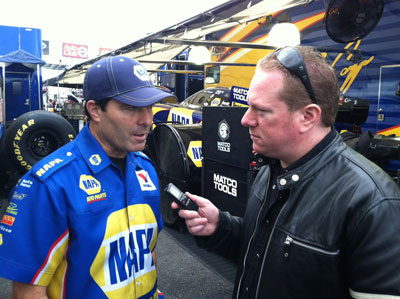 |
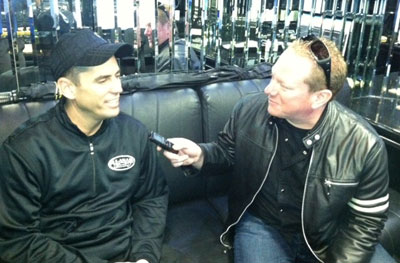 |
Whoever he was, he was my reverse-image alter ego: a hockey writer who loves drag racing. And he even dreams of writing for “my” magazine. We exchanged emails, and I quickly found out that his father was John Hoven, whose name might be familiar to the Insider Nation denizens of the 1970s SoCal scene thanks to his Hoven’s Mach I and Midnight Special floppers. His name is also John Hoven.
It didn’t take us long to become fast friends via email, and I invited him and his 5-year-son, Sebastian (actually John Sebastian Hoven VI), to the Finals, where, after getting the behind-the-scenes nickel tour in Pomona, he did what we journalists do best: He started interviewing people. One of the more popular themes on his website is a feature called “What I’ve learned this season,” in which he asks Kings players what they’ve learned about their teammates this season, and he posed that same type of question to Ron Capps, John Force, Jack Beckman, Larry Dixon, Tony Schumacher, Antron Brown, Spencer Massey, and Jeff Arend, asking them what they’ve learned about fellow racers.
Those interviews – which included some pretty funny stuff – ran in our year-end issue of National DRAGSTER, helping fulfill one of his dreams, and he also did us the honor of sharing the story of his dad with us for today’s Insider. Enjoy!
Remembering my dad, John Hoven
by John Hoven V
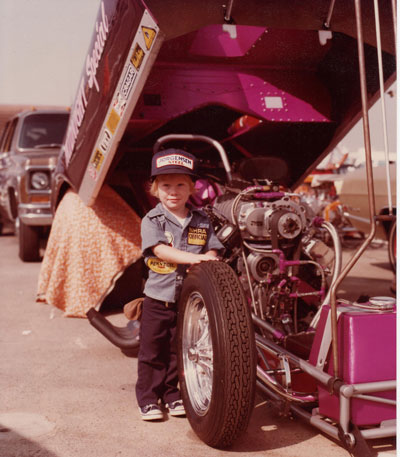 |
Growing up, my dad always told me 1971 was his favorite year. He would often remind me it was the year he married my mom, the year he won the Division 7 points title, and the year I was born.
Still, it's only now, some 40 years later, that I'm truly beginning to understand why those 12 months were so magical for him.
Today, as a husband and a father myself, the stories mean so much more to me.
To hear his sisters tell it, my dad was always working on a race car -- for as far back as they could remember, into his early teens.
Exactly how he got into drag racing I'll never know. He grew up on a farm in Massachusetts and raced all over tracks throughout New England until he came west in 1968 for one reason: to race at Orange County Int'l Raceway.
He had thought about making the trek across the U.S. to race at Lions Drag Strip for a few years. Yet for some reason, he had a love affair with a racetrack 3,000 miles from home, and one he'd never even been to.
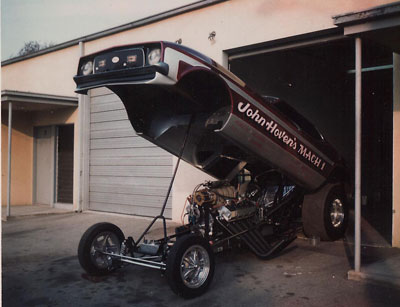 |
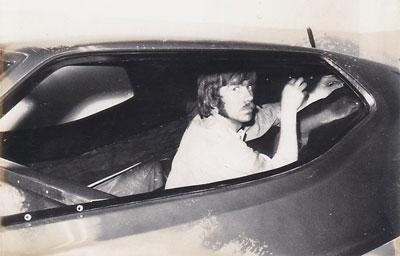 |
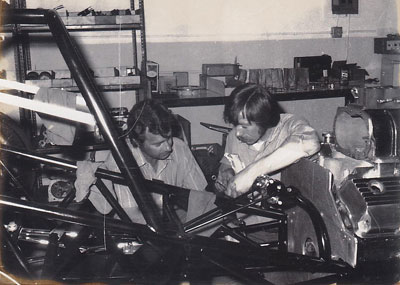
John Hoven, right, with driver Tom Ferraro
|
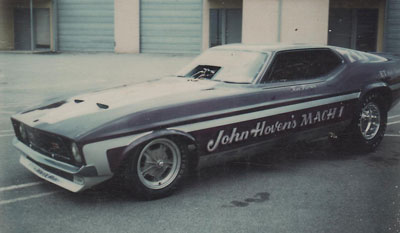 |
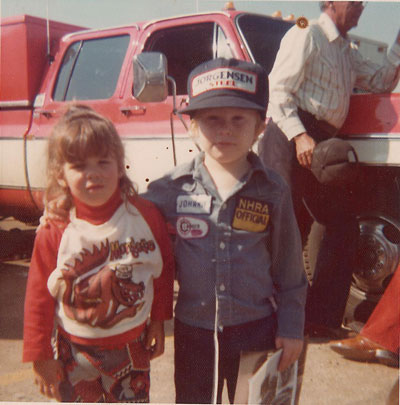 Me with Donna Prudhomme, March 1976 Me with Donna Prudhomme, March 1976 |
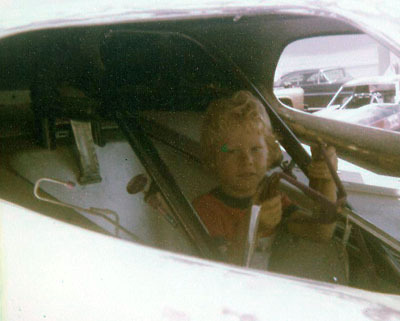 |
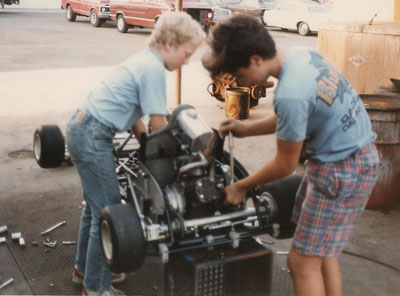 Me, left, with my quarter-midget "crew chief," John Savage Me, left, with my quarter-midget "crew chief," John Savage |
After owning, partnering, and working on several fuel altereds, including the Groundshaker Jr. and Way-Hoven-Okazaki "flower power" car, my dad built his first Funny Car, known as John Hoven's Mach I -- a car that had more purple on it than anybody had ever seen, from the paint job to the tinwork to tons of anodized parts.
A few years later, he would put together his second Funny Car, a Plymouth Satellite known as The Midnight Special. That car was believed to be the first one with a roof hatch for the driver to escape in case of a fire, now commonplace in all Funny Cars.
It was also at OCIR where that car made its last real runs, piloted by legendary Funny Car shoe -- and a man my dad had deep respect for -- Denny Savage.
While testing the car that afternoon, something broke a few hundred feet out, and the car made an immediate left, hitting the guardrail and sending the body flying.
My dad spent the next few years chasing the ever-elusive major sponsor and never returned to the track with his own car again. As an owner of a successful engine-building business, he poured his time into that venture and would help tune and offer advice to boat racers, sprint-car teams, and Funny Car operations like Powers Steel, the Red Baron, Sherm Gunn, John Martin's Jam-Air Special, and several others.
In a little-known trivia fact, both my dad's Funny Cars were featured in the movie Heart Like a Wheel about Shirley Muldowney. The producers bought the Satellite from my dad, and when they told him they were also looking for a Mustang, he put them in touch with the guy he sold the Mach 1 to years earlier. Fortunately, neither of his cars were the ones destroyed in the crash scene. And you can even see my dad's always-present purple butterfly steering wheel in a few of the scenes with “Shirley” in the driver’s seat.
All the while, I found myself roaming dragstrips as a kid, from OCIR to Ontario, Pomona, Firebird, and more, often with John Savage, Denny's son.
Trouble usually wasn't far behind, either. Two of those vivid memories include the time we were busted for standing out in front of Famoso Raceway and charging people money to park in a lot that was supposed to be free. We made a killing that day.
Also, I often profited off of kids at school. When at the drags on the weekends, I would collect the free photo cards given away by the drivers (usually by the handful) and then sell them to my classmates on Monday for a quarter. When my elementary-school teacher found out about it, I'll never forget him saying, "This is a place for learning, not selling."
Those skills came in handy years later, though, when I wanted to go racing myself. I became interested in quarter midgets and asked my parents to get me a car. My dad loved to repeat the story about how when they told me they didn't have the money, I said. “No problem; I'll just get some sponsors.”
Which I did. Using money from A&W Root Beer, Del Taco, Valvoline, and others, my parents never spent one dime on the operation, and I began racing at multiple tracks on the West Coast -- with a car that was painted to match Don Prudhomme's 1982 Pepsi Challenger car. Famed race car painter Tom Stratton did the color, and Grant Meredith, one of my dad's former drivers, did all the lettering.
Oh yeah, John Savage was listed as my crew chief on the front of the car. Nobody had a quarter midget with sponsors or a crew chief. They all thought we were nuts.
Many of the life lessons I learned as a kid revolved around racing and the people my dad came in contact with through racing. For example, he always talked about being a man of your word or doing the right thing and would recall stories like the time Connie Kalitta borrowed a magneto from him at a race. The Bounty Hunter promised to mail it back to him the following week. Instead, he sent my dad a brand-new one, which he thought was one of the most respectful moves he had ever encountered.
Eventually, I stopped racing to concentrate more on school, where writing and public speaking were always my favorite classes. I even talked about wanting to write for National DRAGSTER one day.
In addition to drag racing, we were a sports family, and my other home away from home was Dodger Stadium. However, in 1990, I quickly found a new love in hockey. After going to just one game live, I called and ordered season tickets the next day. And I've never looked back.
Within a few years, I was writing for a local publication, and fast-forwarding to the last five years or so, I've done freelance hockey writing for a variety of publications and websites as well as running my own site (www.MayorsManor.com) dedicated to inside information on the day-to-day activities surrounding the LA Kings, plus interviews with some of the biggest names in the world of hockey.
Still, my love for drag racing has remained present. So it wasn't much of a surprise when my then-girlfriend, now wife, bought me an experience at Frank Hawley's Drag Racing School one year for Christmas. My instructor was "Fast Jack" Beckman, in what turned out to be one of his last classes before moving on to drive a Funny Car full-time.
Besides the passes I made that day down the Pomona quarter-mile, two moments from that day have stuck with me. One, Beckman saying he remembered my dad and being complimentary towards his racing career. I'll never really know if he actually remembered or was just trying to be nice. Regardless, it made me feel good at the time.
The other memory is something he said to me after one of the runs. As was customary, you would drive the dragster back up the return road, and then get out and talk with Beckman about the run. One time, after he asked how it was, I said, “It left pretty good, and then it moved around out in the middle ...” He cut me off, shaking his head side to side like a disapproving father, lowered his voice, and said, “It didn't move around out there.” I just stood there and wondered, “Did it really move around or have I been to too many drag races and heard too many drivers say stuff like that?”
Either way, my five passes were just over 13 seconds each. And those may have been the best combined 65 seconds of my life.
My father was very ill his last few years and passed away in 2007. Yet up until his final days, he would summon the strength to demand to watch two things on TV: his beloved Boston Red Sox and NHRA Drag Racing.
Gone but not forgotten, he still attends two drag races each year. You see, my siblings and I spread some of his ashes at Pomona after he passed. Thus, he still gets to take in the action at the Winternationals and the Finals.
You never forget your parents after they're gone. But when I go to the drags with my son now, I can't help but look around and remember all the memories I had with my dad over there, over there, and over there.
Sharing those moments and stories with my son have just begun and are part of the reason why drag racing means more to me with each passing year.
It just takes one smell of nitro in the pits to transport me all the way back to OCIR and being a kid all over again.
Thanks to John for that wonderful story, which is at the heart of the Nitro Generation theme that NHRA will be pursuing in 2012. Thank you to all who sent Nitro Generation stories to me recently, many of which will be included in the annual Fan Guide early next year and others that will run in National DRAGSTER throughout the year. If you haven’t sent your story, there’s still plenty of time. You can refer back to this article to get the gist of what I’m looking for.
Speaking of the Fan Guide, that’s the project on my plate this week. We completed National DRAGSTER’s 52nd season last Wednesday with the shipping of the year’s final issue to the printer. After last Thursday’s annual NHRA holiday party – where I managed to keep alive my Vandergriffian streak of not winning even a door prize – most of my fellow staffers have hightailed it home for the holidays or are enjoying some well-deserved time off (though they remain active on Twitter).



















































